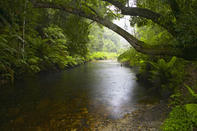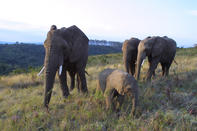Forest Biome
During Miocene times, about 20 million years ago, a period of heavy rainfall allowed riverine and montane forest to spread out and form a near-continuous cover over most of eastern tropical Africa. Then about five million years ago, the aridity of a Pliocene ice age squeezed the forests up the mountain slopes, into sheltering kloofs and along the eastern coastline.

The vertical thrust of a forest aptly reflects its function, for in the competition for light, the trees grow tall and thrust out canopies of broad, bright green leaves high above the ground. The tall trunks are really a communication system between the soil and the canopy, designed to get the leaves to where they can use sunlight to produce food while at the same time providing them with nutrients. The Forest Biome covers only 0,01 percent of southern Africa, of which about 37 percent is conserved.
This seems a high proportion, but the total area conserved is below the minimum size needed to ensure the long-term survival of an ecosystem. The Knysna forest extends along the coast of the Garden Route. Massive columns of buttressed yellowwood and ironwood, Cape holly and stinkwood, Cape chestnut and wild pear are draped with a filigree of lichens and ferns - the forest is something to behold. It is also home to various flowers, as well as the elusive Knysna loerie.
The Knysna forest has dwindled over the years as it has been exploited for valuable timber since the 18th century. The forest is protected by public conservation and local authorities is in charge of around 70 percent of the total indigenous forest area. Nearly 20 percent is conserved in proclaimed nature reserves and national parks.
Animals of the Forest

Elephants in Knysna may be the most unexpected forest residents but are more common in this habitat elsewhere in Africa than their southern African numbers would suggest. The only forest in this region that they inhabit is the Knysna/Tsitsikamma complex and at last count there was only one, at most two, left.
While forest elephants have been shot to near extinction, one of their distant relatives survives there well enough. Forest shrews are small but voracious predators of the forest floor. They scurry through the tangled undergrowth and litter for two hours at a time, hunting for worms and insects, and then they take a quick 15-minute nap between foraging bouts; this goes on for most of the day and night. Their frenetic lifestyle requires that they consume up to 80 per cent of their body weight every day.
Forest shrews (Myosorex spp.) themselves may be in no immediate danger of extinction, but the habitat on which they depend may well be.
 For holiday-makers in search of the dichotomy of relaxation and adventure can rest assured that accommodation in Knysna on the Garden Route ...
For holiday-makers in search of the dichotomy of relaxation and adventure can rest assured that accommodation in Knysna on the Garden Route ... Knysna lies on the banks of a tranquil lagoon, guarded at its mouth by The Heads and overlooked to the north by the Outeniqua Mountains....
Knysna lies on the banks of a tranquil lagoon, guarded at its mouth by The Heads and overlooked to the north by the Outeniqua Mountains....